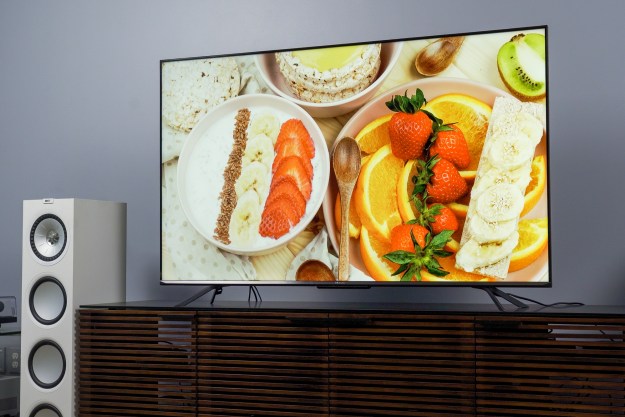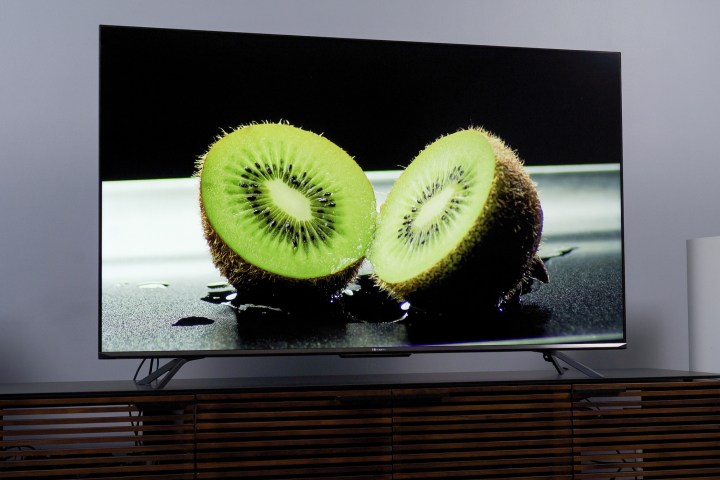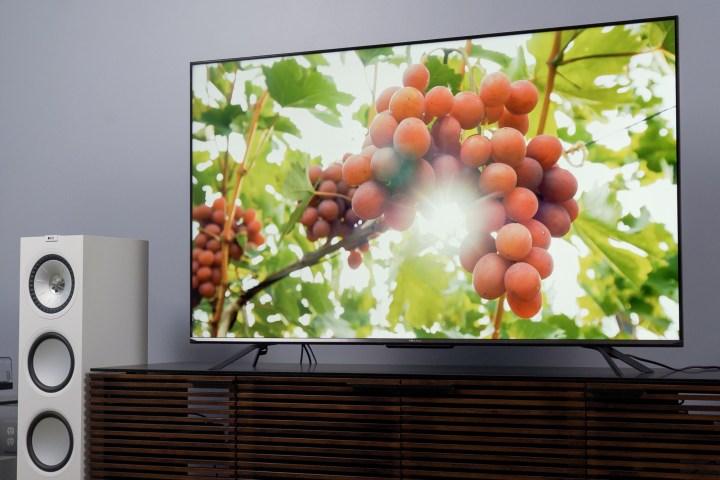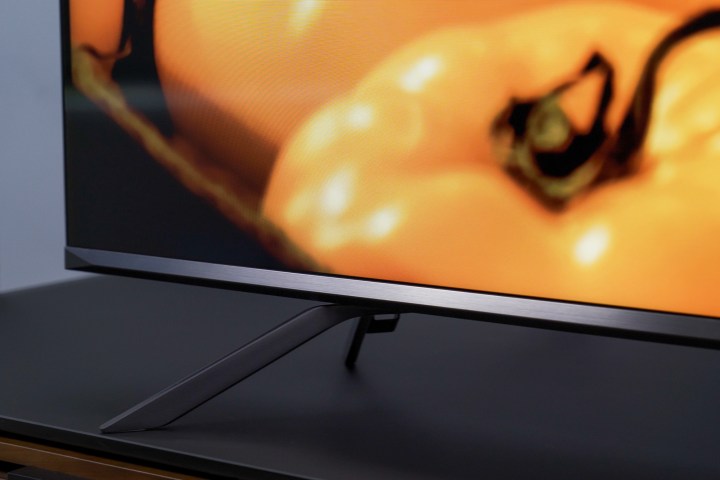
- Impressive brightness
- Solid black levels
- Excellent backlight control
- Great for gaming
- Easy setup
- Poor off-angle performance
- Potential dirty screen effect
My pick for the best TV under $1,000 has gone to a TCL TV for the past few years, but this year, Hisense at the very least co-owns that coveted spot with its U7G 4K ULED TV. Priced well below $1K, this TV outperforms my expectations at nearly every turn — and that’s through the lens of a very picky TV enthusiast (me).
For most folks, the U7G is absolutely a no-brainer pick. Here’s why.
Out of the box

Over the course of my 29 years in the field of consumer electronics, I have preached that a heavy device is a premium device. Of course, there are limits to that notion — you don’t want a 25-pound pair of headphones. But, by and large, the best devices in any given category tend to have some heft because, even in this digital age, quality components tend to weigh more than cheap components.
By that measure, the Hisense U7G wouldn’t be considered a premium TV. It’s astonishingly light. So much so that I had real concerns about its overall build quality and its potential to impress me with its performance. But as I’ve been very easily moving the U7G around from spot to spot in my testing lab, I’ve determined that this TV is built just fine and should stand the test of time.

As a bonus, the U7G is a cinch to assemble and mount on the wall. There are just a couple of feet to install for stand mounting, and for those who will use a media center or credenza, the U7G’s footprint spans 47.75-inches wide by 10.5-inches deep.
In the box with the TV are the feet, screws for the feet, a Google voice remote, batteries for the remote, and a smattering of paper-printed product literature that one probably doesn’t need.
U7G Series details
While we reviewed the 65-inch 65U7G model, our review also applies to the other screen sizes available in the series.
| Screen Size | Model Number | MSRP |
| 55-inch |
55U7G
|
$700 |
| 65-inch | 65U7G | $900 |
| 75-inch | 75U7G | $1,200 |
Setup

One of the things I enjoy most about Hisense TVs is their ease of setup — specifically in regards to getting the right picture mode presets for all the various inputs and streaming apps on board.
I realize a lot of folks buy a TV, plug it in, turn it on, endure the requisite setup wizard, and then promptly go about watching TV without ever touching the picture settings. This is a shame. To get the best picture out of any TV — and especially the Hisense U7G — it pays to take a little time to at least make a few easy adjustments.
By default, the TV will be in a standard picture preset, which may ultimately suit your taste, but the TV will also be in an energy-saving mode which I highly encourage users to turn off right away. This eco setting will cap the TV’s peak brightness, and if one doesn’t turn this off, they’ll never know what their TV can really do.
Once the TV’s eco mode is disabled, I would also suggest turning off motion smoothing. While motion smoothing is helpful for some fast-moving sports content, it makes movies and some TV shows look artificial, introducing soap opera effect, which I consider dreadful. Not everyone agrees with me on this, however, so if you like the smooth-looking motion, feel free to leave it turned on — just know that I will never come over to watch TV with you.
Personally, I think the pro move is to select Theater Day as the picture mode. If the color temperature looks a little warm to you or it seems as if the picture isn’t as vibrant, that’s normal. Give your eyes a chance to get used to it. I think you’ll find it looks a lot more authentic. Theater Day also give you the best brightness output for SDR content without having to mess with any other settings.

Once Theater Day is selected for one HDMI input, it will be selected for the others as well. And if you select Theater Day in one streaming app, it will be the default for other streaming apps (again, this is for SDR content). Most TVs don’t offer this convenience, which is why I praise Hisense for making TV setup easy.
For HDR content, I suggest selecting
One final note on setup: The Android TV/Hisense setup wizard is going to throw a lot of privacy-related questions your way. Take a moment to read this stuff and choose wisely depending on how comfortable you are with data collection on your viewing habits. Also know that you can choose to keep your viewing data for yourself, but it will be at the expense of relevant content suggestions.
Measurements/specs

As is my custom for TV reviews, I used a Spectracal C6 colorimeter profiled to an X-Rite i1Pro spectrometer, along with Calman Ultimate software, to measure the U7G’s out-of-the-box performance before I made any detailed adjustments. Since few people are going to pay to have a TV like this calibrated, I think these numbers are the most valuable.
I checked peak luminance performance for SDR in Theater Night (283 nits) and Theater Day (566 nits). Theater Day looks just bright enough to offer a good-looking picture in a room with a moderate amount of daylight coming in. This is not mind-blowing brightness, but definitely above par for TVs priced below $1K. The backlight setting can be bumped up to increase brightness in brighter rooms, but the black levels will take a hit and start looking a little grayish.
For the
Interestingly, I found that the
I also checked the U7G’s out-of-box two-point grayscale performance and found it was impeccable. And I don’t just mean on point for Hisense, I mean the grayscale was at Sony A80J levels of accuracy. I expected this to translate into excellent color accuracy, but oddly enough, that didn’t turn out to be the case.
Normally, accurate grayscale means the colors are going to track well, but technically speaking, the TV has color errors that go into the visible spectrum. However, they are not so significant that I think most viewers would notice.
Given the TV is so inexpensive, a videophile on a budget might do well to pick up the U7G and have a professional calibrate the color. For the modest increase in overall cost of ownership, I think the return might be worth it to the right person. Most folks, however, will be pleased as punch with the color, if not downright impressed.
Backlight and black levels

I am extremely impressed with the Hisense U7G’s backlight performance. I witnessed little to no crushing of blacks (where dark grays/shadow detail is represented as black). There was also surprisingly little blooming and halo effect around bright objects on dark backgrounds, which is impressive when considering how bright the TV can get.
I have a new favorite piece of content for checking black levels, shadow detail, blooming, and halo effect all at once: Night on Earth, which is available on Netflix. I watch the show with closed captions turned on and I will quickly learn just about everything I need to know about a TV’s backlight control and black level performance..
The great thing about this Netflix nature docuseries is that it is filmed almost entirely at night — hence the title. They use special cameras and technology to capture night images — action in nature that’s never before been seen. The show, on average, is extremely dark, except where it isn’t, which makes for one hell of a torture test, and let me tell you the U7G passed the test with ease.

I observed almost no perceivable blooming from the edges of the TV or halos around bright objects, the best test of which is around the closed captions, which are bright white on an almost jet black background. It’s rare that I’m not distracted by a backlight system when watching dark content, but the U7G had me simply enjoying the content — that’s a big endorsement.
Motion and processing
Motion performance was good — right in the midrange overall. I did see a little bit of stutter and flicker with vertically panned shots, but it wasn’t a consistent problem. Motion issues didn’t occur often enough for me to get upset, which means I think most folks will be very pleased with this TVs presentation.
Upscaling and processing, in general, were just OK. The U7G doesn’t clean up noise as well as, say, a Sony TV, but then again, most TVs don’t. In particular, I noted a little bit of color banding in low bit-depth content from
Gaming

According to the Xbox Series X
The U7G is going to be great for gamers. The input lag is super low (below 15 milliseconds for
Bonus features
The Hisense U7G is an
Our take
The U7G, right now, is the best TV you can buy for under $1,000. That honor was once shared with the TCL R645, however, that TV’s price has soared due to supply chain issues, so for now, the U7G owns that title. I’d also have to call the U7G the
Is there a better alternative?
At the price point, no. The U7G offers a unique value in 2021. However, the Hisense U8G offers just slightly higher performance (brightness) for $100 to $200 more.
How long will it last?
The Hisense U7G, from a performance and features standpoint, is positioned to function well for several years. Hisense provides a one-year parts and labor warranty for its TVs provided they are used in a non-commercial setting.
Should you buy it?
Yes. The U7G is a great TV. It’s low price makes it a no-brainer buy.
Editors' Recommendations
- Hisense kicks off its U8K mini-LED TV availability with deep discounts
- Hisense debuts its first 8K Roku TV, the 75-inch U800GR
- TCL rolls out 4K HDR Android TV models starting at $200
- You can currently buy a 70-inch Samsung 4K TV for less than $550





